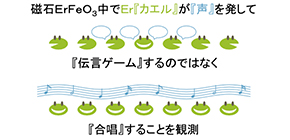
Long-range interactions of erbium ions in magnet discovered
Will lead to development of quantum computer and technology of direct conversion of heat to light
Researchers from Osaka University and Rice University (U.S.) found that erbium (Er) ions influenced each other in the magnet erbium orthoferrite (ErFeO 3 ) and exhibited Dicke cooperativity; that is, the material’s dipoles, the compass-like magnetic force inherent in every atom, are excited and prompted to align. This is just like how one frog’s call may trigger calls of responding frogs in chorus.
Cooperation and synchronization in groups, such as calls of responding frogs in chorus triggered by one frog’s call or synchronous flashing of fireflies, are frequently observed in our living environment. Similar phenomena can be observed in magnets as well.
A magnet is an object made from magnetized material, so each element of a magnet is itself a small magnet. If the magnetization is aligned in a uniform direction, the magnet exhibits strong magnetism.
It was believed that a group of elements (small magnets) were aligned in the same direction while adjacent or nearby elements influenced each other, just like a “telephone game” in which a message is conveyed from the first person to the second person in line. On the other hand, there was an opinion that a group of elements might be aligned in the same direction to form a magnet just like a collective frog chorus, in which the call of one frog is heard by other distant frogs, causing them to sing in sync. This, however, has not yet been proven.
Using a magnetic field to prompt cooperativity among spins within the crystalline compound ErFeO 3 , this group found that while the iron (Fe) ions could be triggered to form a spin wave at a particular frequency, electron paramagnetic resonance of the Er ions formed a two-level quantum structure that interacted with the spin wave. They confirmed that the magnitude of interaction was proportional to the square root of the density of Er ions, evidencing Dicke cooperativity.
This group plans to observe cooperative quantum magnetism through cooperative coupling of Er atoms at long ranges. There is a possibility that further development of this group’s achievements will prevent quantum noise in quantum computing technology.
In addition, this group tries to find matter that will become a magnet by prompting cooperativity among spins not through a coupling system with Fe atoms, but through a light-atom coupling system in similar experiments using other magnets. If such material is discovered, it may emit a laser-like light when it loses its magnetism with an increase in temperature by heat. It may lead to the establishment of technology that directly converts heat to light.
Abstract
The interaction of N two-level atoms with a single-mode light field is an extensively studied many-body problem in quantum optics, first analyzed by Dicke in the context of superradiance. A characteristic of such systems is the cooperative enhancement of the coupling strength by a factor of N. In this study, we extended this cooperatively enhanced coupling to a solid-state system, demonstrating that it also occurs in a magnetic solid in the form of matter-matter interaction. Specifically, the exchange interaction of N paramagnetic erbium(III) (Er 3+ ) spins with an iron(III) (Fe 3+ ) magnon field in erbium orthoferrite (ErFeO 3 ) exhibits a vacuum Rabi splitting whose magnitude is proportional to N. Our results provide a route for understanding, controlling, and predicting novel phases of condensed matter using concepts and tools available in quantum optics.

Figure 1

Figure 2
The article, “Observation of Dicke Cooperativity in Magnetic Interactions” was published in Science at DOI: https://doi.org/10.1126/science.aat5162 .
Related link
